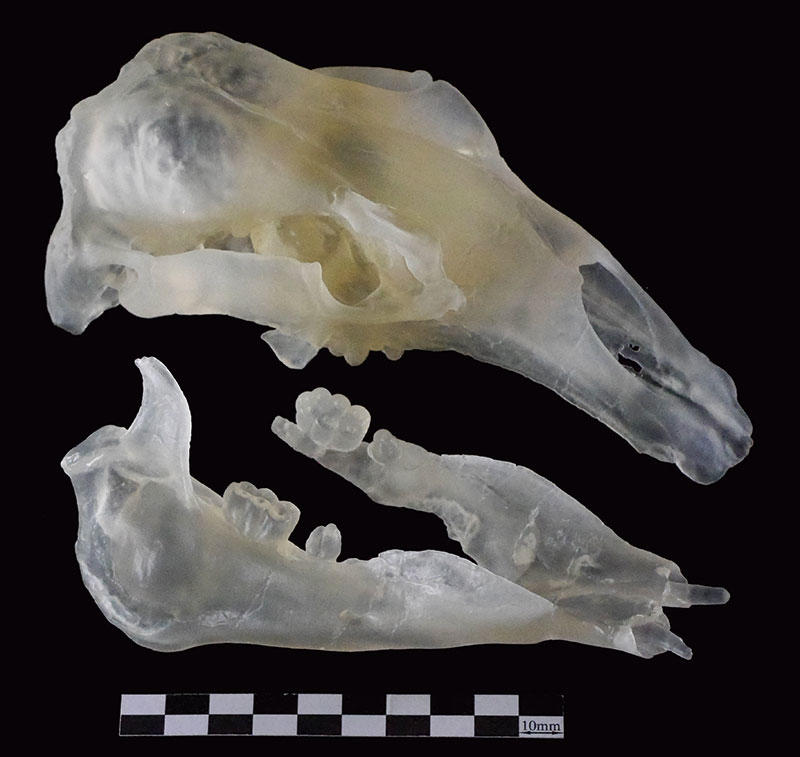Bulletin of the Geological Survey of Japan Top Page
Bulletin of the Geological Survey of Japan Vol.67 No.5 (2016)
Cover photograph | Table of Contents | Abstract
Cover photograph
A 0.4 times size model of a skull of Desmostylus by 3D printer (Scale length is 10 cm)
The Utanobori specimens of Desmostylus were uncovered from the Middle Miocene Tachikaraushinai Formation at Esashi Town, Hokkaido, Japan. Some descriptions dealt with the Utanobori specimens have been published, but the 2nd to 7th Utanobori specimens remain unpublished. In this issue, these unpublished specimens are formally described, and the 1st and 8th Utanobori specimens are also redescribed based on new knowledge.
The Utanobori specimens will provide new information through new technology such as X-ray CT scanning and isotope analyses. The cover picture of this issue is 0.4 times size model of the skull of the 3rd Utanobori specimens (GSJ F07745-1, GSJ F07745-2) by using 3D printer based on X-ray CT scanning data. Description of the Utanobori specimens is completed in this issue, expanding opportunity to be used in various studies.
(Photograph and Caption by Naotomo Kaneko)
Table of Contents
All the pages PDF : 67_05_full.pdf [9MB]
| Title | Author | |
|---|---|---|
| Frontispieces | ||
| Modeling of geological specimen by 3D printer |
Naotomo Kaneko, Hikaru Uno and Tomohiro Iwashita(p133-135)
|
67_05_01.pdf [4.8MB] |
| Article | ||
| Description of the rest of previously studied Utanobori specimens of Desmostylus from Esashi Town, Hokkaido, Japan |
Hikaru Uno, Naotomo Kaneko and Takamune Takabatake(p137-165)
|
67_05_02.pdf[13.8MB] |
| The skeleton of Desmostylus from Utanobori, Hokkaido, Japan, III. Redescription of the 8th Utanobori specimen and reconsideration for cranial morphology of the 1st specimen |
Norihisa Inuzuka, Naotomo Kaneko and Takamune Takabatake (p167-181)
|
67_05_03.pdf [6MB] |
Abstract
Description of the rest of previously studied Utanobori specimens of Desmostylus from Esashi Town, Hokkaido, Japan
Hikaru Uno, Naotomo Kaneko and Takamune Takabatake
Utanobori specimens of Desmostylus stored in AIST, Geological Museum, Tsukuba, Ibaraki, Japan were excavated from the Middle Miocene Tachikaraushinai Formation at Esashi Town (former Utanobori Town), Hokkaido, Japan. Some specimens of them was not formally described, and these specimens were described in this paper. All the 1st to 7th Utanobori specimens were considered to be D. hesperus, based on the morphology and geological age. Regarding the 3rd Utanobori specimens studied in this paper consisting of several specimens (GSJ F07745-4, GSJ F07745-6, GSJ F07745-7, GSJ F07745-8, GSJ F07745-13, GSJ F07745-14), they were collected within an identical rock. All of the 3rd Utanobori specimens showed nearly same growth stage and did not include overlapped bone elements. Thus, they were highly probable from an identical individual. Comparing stylohyoid, incisor, tibia of the 3rd Utanobori specimens with other corresponding specimens of D. hesperus (the 1st Utanobori specimen; GSJ F07743 and the Keton specimen; UHR18466), the stylohyoid of the 3rd Utanobori specimens was much delicate comparing to that of the 1st Utanobori specimens, and the occlusal surface of incisor was worn in different manner from that of the 1st Utanobori specimens. The tibia of the 3rd Utanobori specimens did not have distortion like those of the 1st Utanobori and Keton specimens. These morphological variations showed some intraspecific-variation of D. hesperus or difference in preservation state.
The skeleton of Desmostylus from Utanobori, Hokkaido, Japan, III. Redescription of the 8th Utanobori specimen and reconsideration for cranial morphology of the 1st specimen
Norihisa Inuzuka, Naotomo Kaneko and Takamune Takabatake
The 8th Utanobori specimens described previously are re-described, because of misidentification of the side and direction of the patella and osteologically insufficient description and discussion of
the humerus. The right humerus (OME-U-0170) is more than 525 mm in length, and the left patella (OME-U-0171) is 112 mm in maximum thickness. The body length of an adult male Desmostylus is
estimated at 387 cm and the weight at about 3.5 t from the largest humerus. The patella about 50 percent thicker than that of an Asiatic elephant suggests a larger moment arm of the knee extension, which proves
that Desmostylus had a lateral-type limb posture.
In the appendix, the cranial morphology of the 1st Utanobori specimen is reconsidered based on addition of specimens for comparison.
Geological Survey of Japan, AIST
- About GSJ
- Our Activities
- Purchase guide
-
Publications and Database
- information
- Bulletin of the Geological Survey of Japan
- bull2025(Vol.76)
- bull2024(Vol.75)
- bull2023(Vol.74)
- bull2022(Vol.73)
- bull2021(Vol.72)
- bull2020(Vol.71)
- bull2019(Vol.70)
- bull2018(Vol.69)
- bull2017(Vol.68)
- bull2016(Vol.67)
- bull2015(Vol.66)
- bull2014(Vol.65)
- bull2013(Vol.64)
- bull2012(Vol.63)
- bull2011(Vol.62)
- bull2010(Vol.61)
- bull2009(Vol.60)
- bull2008(Vol.59)
- bull2007(Vol.58)
- bull2006(Vol.57)
- bull2005(Vol.56)
- bull2004(Vol.55)
- bull2003(Vol.54)
- bull2002(Vol.53)
- bull2001(Vol.52)
- Bulletin of the Geological Survey of Japan(old)
- Annual Report on Active Fault and Paleoearthquake Researches
- Reports, Geological Survey of Japan
- CCOP-GSJ Groundwater Project Report
- CCOP Technical Bulletin
- Cruise Report
- Geological Hazards
- Learning and Education
- GSJ Database Collection
- Collection of links


